| An Introduction to LDAP: Part 1-LDAP Primer 
Posted: 21 Jun 2005
Applies to
What is LDAP?
LDAP stands for Lightweight Directory Access Protocol. LDAP is a protocol which provides access to a compliant
directory via TCP/IP. The
strengths of LDAP-compliant directories include speed, simplicity, and the
ability to be replicated and distributed across several servers. A LDAP
directory can be used to store a great deal of information: from user login
credentials to company telephone directories.
LDAP was created as a less complicated
implementation of the Directory Access Protocol (DAP), and is based on the OSI X.500 standard. These
standards establish directories as being hierarchical---representing the
structure of an organization. There are many directories that support the LDAP
protocol, each with their own benefits and drawbacks. Examples include openLDAP,
the open-source implementation that ships with SLES; and eDirectory, Novell's
flagship identity management product.
Directories vs. databases
The terms directory and database are often used interchangeably
when referring to LDAP compliant directories. In this article, directory
refers to a LDAP complaint directory, and database refers to relational
databases, such as MySQL or Oracle. The two are related, in that they both store
information in a structured way, but differ in their implementation. In many
cases, directories and databases could both fulfill a particular need. It is
important to understand the differences between the two to best determine which
to implement.
The largest general difference between directories and databases is
complexity. Databases are capable of storing almost any arbitrary set of
information and can can be greatly customized for a specific purpose. They also
provide a complex query interface, allowing for flexible searches returning
customized results. Directories, on the other hand, tend to have very specific
implementations that follow a strict pattern or schema. This allows them to be
extremely fast, and allows for easy organization and comprehension of the data
they store.
From a technical standpoint, the main differences include:
-
Layout. A database can been seen as a series of tables, or
spreadsheets, consisting of rows and columns. Each column is a field, and each
row is an entry, providing data for the fields. Tables can be related by one
or more column, and complex queries select data based on combinations of rows
and columns from various tables. For example, one table may list employee
names and the department they belong to and another may list employee names,
their phone numbers, and their cubicle numbers. A query can combine the two
tables to return the names and phone numbers of all employees in a specific
department. An example company, example.com, has the following database
tables, and a query for the phone numbers of all engineers returns the
following results:
Table 1: Employee/department relationships
|
first_name |
last_name |
department |
|
Jay |
Smith |
Engineering |
|
Joseph |
Wilson |
Engineering |
|
John |
West |
Engineering |
|
Sally |
Stevens |
Sales |
|
Jane |
Doe |
Marketing |
Table 2: Employee phone numbers
|
first_name |
last_name |
phone_number |
cubicle_number |
|
Jay |
Smith |
345-2332 |
E23 |
|
Joseph |
Wilson |
345-2312 |
E30 |
|
John |
West |
345-9393 |
E21 |
|
Sally |
Stevens |
345-2211 |
T55 |
|
Jane |
Doe |
345-3321 |
T33 |
Table 3: Result of query selecting names and phone numbers of all
engineers
|
first_name |
last_name |
phone_number |
|
Jay |
Smith |
345-2332 |
|
Joseph |
Wilson |
345-2312 |
|
John |
West |
345-9393 |
A
directory, on the other hand, is best viewed as a hierarchical tree. It is
comparable to a computer file system with folders and files. The organization,
example.com, has a tree like this:
Figure 1: Example tree 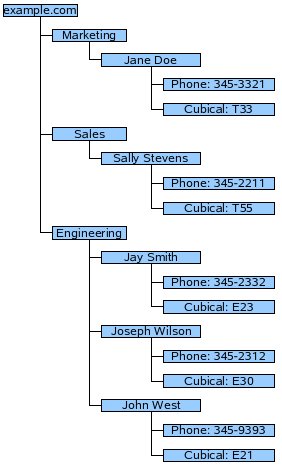
It is
easy to see that, based on the layout of the data, databases can be arranged to
allow for extremely powerful and complex queries. Directories, on the other
hand, allow for only simple queries such as listing the contents of a given
sub-tree. These simple queries are strait-forward and easy to execute.
In
addition, unlike a database, a directory can contain multiple entries for each
data type. For example, suppose John West has more than one phone at his desk.
In a directory, the new phone entry can simply be added to his sub-tree. In a
database, an entire new column in the table needs to be created, wasting space
for all the other people who don't have two phones.
-
Access Time. Directories are optimized for fast reads, but
have slow writes. This is largely due to their simple query structure. As a
result, it is not good to store frequently changing information in a
directory. They are primarily used for mostly static information, such as
telephone directories. Constantly changing information such as store
inventories should be stored in a database.
-
Replication and Transactions. Directories allow their trees to
be partitioned and replicated among several servers. For illustration,
example.com has their main headquarters with the sales and marketing
departments at one location, and the engineering department at a location
across the country. They host their entire directory at corporate
headquarters, but partition off the engineering tree and have it hosted at
their satellite location as well. The engineering copy is synchronized with
the master copy occasionally. This speeds the access time for the engineers to
their own tree, and reduces the network bandwidth used between the two
locations.
Inherent
in this model is a lack of consistency between the master copy and the
replicated copy. If data on the master copy is changed, it is not immediately
available on the local copy. In directories this is considered to be acceptable.
Directories generally do not support the strict transactions which databases
rely on. In a database, all reads and writes are ensured to either entirely
happen, or not happen at all through transactions, making them perfect for data
that must maintain consistency, such as banking account information. Directories
contain largely static information and do not have this requirement.
LDAP concepts
As mentioned above, directories are
viewed as a tree, like a computer's file system. This overall tree structure is
called the Directory Information Tree (DIT). Each entry in a directory is called an
object. These objects are of two types, containers and leafs. A container is like a folder: it contains other
containers or leafs. A leaf is simply an object at the end of a tree. A tree
cannot contain any arbitrary set of containers and leafs. It must match the
schema defined for the directory. Using a common scheme, the organization
example.com has the following simplified DIT:
Figure 2: Example DIT
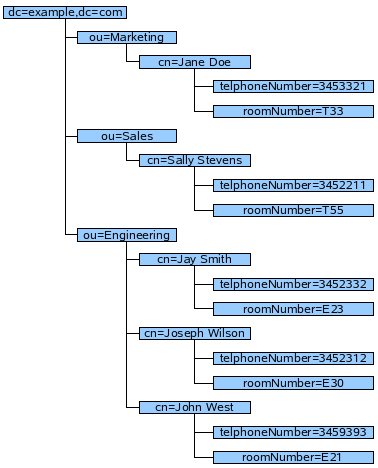
This example
contains several abbreviations specific to the scheme being used. They all stand
for different elements of the organization:
-
dc –
domain component. Each element of the Internet domain name of the
company is given individually.
-
ou –
organizational unit. The company is divided into its individual
organizations.
-
cn –
common name. The common name a person. The leaf objects under this
container describe elements of this person.
In this example
'dc=example,dc=com', 'ou=Marketing', and 'cn=Sally Stevens'
are all examples of container objects. Leaf objects include
'telephoneNumber=3452211' and 'roomNumber=T55'.
Much like computer
file systems, directories also support the concept of a path. In a
directory, this is called a Distinguished Name (DN). The DN for John West
is: cn=John West,ou=Engineering,dc=example,dc=com. It is built by
individual Relative Distinguished Names (RDN's), separated by commas.
Depending on the directory being used, each RDN should be separated by either a
comma or a period.
openLDAP on
SLES
SLES uses the
open-source implementation of LDAP, called openLDAP. It is already be installed
on any system that uses the default installation settings. There are only a few
files that generally need to be accessed directly:
-
/etc/openldap/sldap.conf – The main configuration file for
openLDAP. It contains sections for defining the schema of the directories, the
access control settings for the directories, and the general settings for each
individual directory.
-
/etc/openldap/schema/*.schema – Directories follow specifically
defined schemes. These .schema files define several standard schemes.
Referencing these .schema files in /etc/openldap/sldap.conf applies these
schemes to the openLDAP directories.
-
/etc/init.d/ldap
– The init script used to start, stop, and restart the openLDAP
service.
There is extensive
documentation available for /etc/openldap/sldap.conf and the .schema files in
the SUSE LINUX Enterprise Server Administration Guide, sections 21.8.2
and 21.8.3. For additional information on various LDAP schema standards, see the
Internet RFC/STD/FYI/BCP
Archives. The files in
/etc/openldap/schema/ are well commented and often list which RFC standards they
contain elements of.
SLES has great a
YaST module for managing the settings for openLDAP. Following is a brief
introduction to configuring and adding a new directory for example.com.
-
To get to the
module, open the YaST Control Center, and select Network Services > LDAP
Server. The first option is whether to
start the server on system boot. Leave this as yes and select
configure.
Figure 3: LDAP Server Module
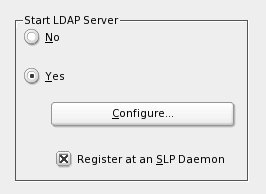
-
The next screen
allows for configuration of the LDAP server and directories. There is a
navigation pane on the left. For example, selecting Global Settings >
Schema Files shows the current schemes being used, and allows for schemes
to be added or removed. For more in-depth information about LDAP configuration
with YaST, see section 21.8.5 in the SUSE LINUX Enterprise Server Administration Guide.
Figure 4: Schema Configuration
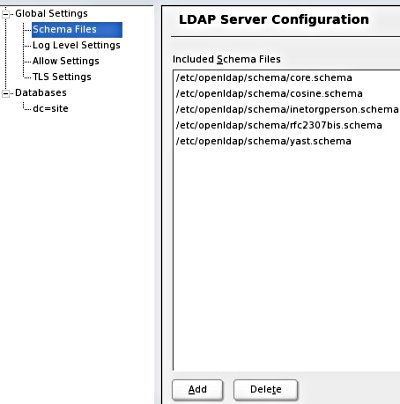
-
The
Databases section shows the currently configured directories. If SLES
is installed with the defaults there will be one directory, site, which
contains the login information for the users on this system. Create a new
directory be selecting Databases in the left pane, and clicking Add
Database. A new window is displayed which allows for new database
information to be entered. Fill in all the fields as follows:
-
Base DN:
dc=example,dc=com
-
Root DN:
cn=Admin (Be sure Append Base DN is checked. Otherwise this
field would need: cn=Admin,dc=example,dc=com)
-
LDAP Password:
Enter a new password for the directory and select the encryption method.
-
Database
Directory: /var/lib/ldap/example.com/
This is the path
to a folder where the directory files will be stored. Make sure the folder
already exists.
Figure 5: Database Configuration
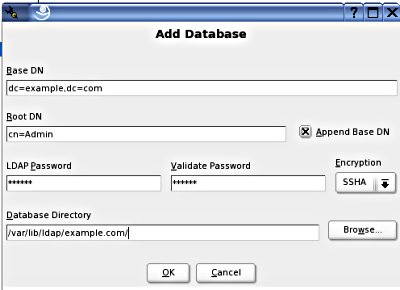
-
Select OK
and notice the new directory now shows up in the database list. Select
Finish to commit the changes.
-
The new directory
for example.com has now been set up. It has the base DN of
dc=example,dc=com and an administrator user,
cn=Admin,dc=example,dc=com. It is now ready to have additional entries
added either by other clients which administer LDAP directories (such as the
Network Services > LDAP Client), or by using the openLDAP
command-line tools. The following section goes over these tools. For more
information about using the LDAP Client, see Part 2 of
this article.
Using the
openLDAP command-line tools
openLDAP provides
several command-line tools to add, modify, view, and delete objects from a
directory. In this section, these tools are used to show how to manage the
example.com DIT shown in Figure 2 above.
The openLDAP
commands all share some common flags. The most important flags are outlined in
Table 4.
Table 4: The openLDAP
flags
|
Flag |
Meaning |
|
-x |
By default, SASL authentication is used. -x causes simple
authentication to be used instead. |
|
-D <DN of Administrator user> |
Specifies the user to authenticate for the current
operation |
|
-W |
Prompts for the LDAP password |
|
-f <file.ldif> |
Specifies the file to import commands from. |
|
-b <base DN of current operation> |
Specifies the base DN to use for the current
operation. |
-
ldapadd – The
ldapadd command is used to insert objects into a DIT. It makes use of LDIF
files to add multiple entries to a DIT at once. The LDIF format is simple, and
is best shown by example. The hash (#) character indicates a line is a
comment. For more information about LDIF files, see the slapd.replog(5) man
page. Create a file called example.ldif which contains the
following:
#Begin by adding example.com's departments
dn: ou=Marketing,dc=example,dc=com
objectClass: organizationalUnit
ou: Marketing
dn: ou=Sales,dc=example,dc=com
objectClass: organizationalUnit
ou: Sales
dn: ou=Engineering,dc=example,dc=com
objectClass: organizationalUnit
ou: Engineering
#Next, add the employees, their phone numbers, and their cubicle
numbers.
#Notice that the schema require more information than was originally
represented in the simple example.com DIT.
#Also notice how the employees are sorted into their organizations: Their
DN places them under the ou (oranizational unit)
#they should belong to.
dn: cn=Jane Doe,ou=Marketing,dc=example,dc=com
objectClass: inetOrgPerson
cn: Jane Doe
givenName: Jane
sn: Doe
telephoneNumber: 3453321
roomNumber: T33
dn: cn=Sally Stevens,ou=Sales,dc=example,dc=com
objectClass: inetOrgPerson
cn: Sally Stevens
givenName: Sally
sn: Stevens
telephoneNumber: 3452211
roomNumber: T55
dn: cn=Jay Smith,ou=Engineering,dc=example,dc=com
objectClass: inetOrgPerson
cn: Jay Smith
givenName: Jay
sn: Smith
telephoneNumber: 3452332
roomNumber: E23
dn: cn=Joseph Wilson,ou=Engineering,dc=example,dc=com
objectClass: inetOrgPerson
cn: Joseph Wilson
givenName: Joseph
sn: Wilson
telephoneNumber: 3452312
roomNumber: E30
dn: cn=John West,ou=Engineering,dc=example,dc=com
objectClass: inetOrgPerson
cn: John West
givenName: John
sn: West
telephoneNumber: 3459393
roomNumber: E21
Make sure there is no
trailing white space at the end of the lines—this will cause a syntax error. The
entries can now be inserted into the directory with the following ldapadd
command:
ldapadd -x -D cn=Admin,dc=example,dc=com -W -f
example.ldif
If there are no syntax or schema errors, the output shows that the
entries were all successfully inserted:
> ldapadd -x -D cn=Admin,dc=example,dc=com -W -f
example.ldif
Enter LDAP Password:
adding new entry "ou=Marketing,dc=example,dc=com"
adding new entry "ou=Sales,dc=example,dc=com"
adding new entry "ou=Engineering,dc=example,dc=com"
adding new entry "cn=Jane
Doe,ou=Marketing,dc=example,dc=com"
adding new entry "cn=Sally
Stevens,ou=Sales,dc=example,dc=com"
adding new entry "cn=Jay
Smith,ou=Engineering,dc=example,dc=com"
adding new entry "cn=Joseph
Wilson,ou=Engineering,dc=example,dc=com"
adding new entry
"cn=John West,ou=Engineering,dc=example,dc=com"
-
ldapsearch – The
ldapsearch command is used to return all or part of a DIT. The syntax is
similar to that of the ldapadd command. For example, the command:
ldapsearch -x -b dc=example,dc=com
returns the entire contents of the DIT. Notice that all the entries
added in the LDIF file above are returned, as well as one more:
dn: dc=example,dc=com
dc: example
o: example
objectClass: organization
objectClass: dcObject
This entry was created by the LDAP Server module, and is the
object representing the root of the tree.
It is possible to restrict the search results in a couple of ways.
The first is to restrict the branches of the tree being searched. This is done
by restricting the search base further. For example:
ldapsearch -x -b ou=Engineering,dc=example,dc=com
returns only the ou=Engineering container, and everything below it. This includes
the three people under the Engineering branch.
The next restriction can come as a filter. For example, we may want
to return only the employees with a cubicle in building E. The entire tree can
be searched, but then filtered on the cubicle number:
ldapsearch -x -b dc=example,dc=com “(roomNumber=E*)”
This search returns only the entries for the engineers.
-
ldapmodify – The
ldapmodify command allows for the information currently in a directory to be
changed. Its syntax and behavior are nearly identical to the ldapadd command.
It takes a LDIF file as input and makes the changes contained to the
directory. For example, if Joseph Wilson moves to cubicle E22 his information
is changed with the following LDIF file (change.ldif):
dn: cn=Joseph Wilson,ou=Engineering,dc=example,dc=com
changetype: modify
replace: roomNumber
roomNumber: E22
The directory is modified with the following:
ldapmodify -x -D cn=Admin,dc=example,dc=com -W -f
change.ldif
The password is prompted for and the contents are modified.
Both the ldapadd and ldapmodify commands can take
input directly from the keyboard as well. Simply leave the -f
<file.ldif> flag off and the
modification can be entered after the password is prompted for. Use
<CRTL>-D to exit when all changes have been made.
-
ldapdelete – The
ldapdelete command removes one or more entry from a tree. The syntax is
similar to the other commands, with the exception of a recursive operation
flag, -r. If ldapdelete is called on anything other than a leaf object, the -r
flag must be used to avoid an error message.
For example, to delete the leaf object Jane Doe, enter the
following:
ldapdelete -x -D cn=Admin,dc=example,dc=com -W
“cn=Jane Doe,ou=Marketing,dc=example,dc=com”
To delete the entire engineering tree, enter the following:
ldapdelete -x -r -D cn=Admin,dc=example,dc=com -W
ou=Engineering,dc=example,dc=com
| 




